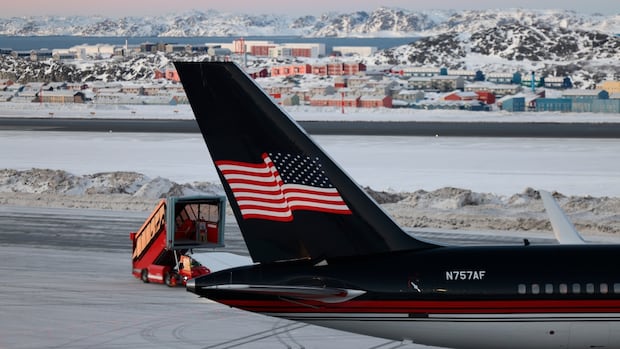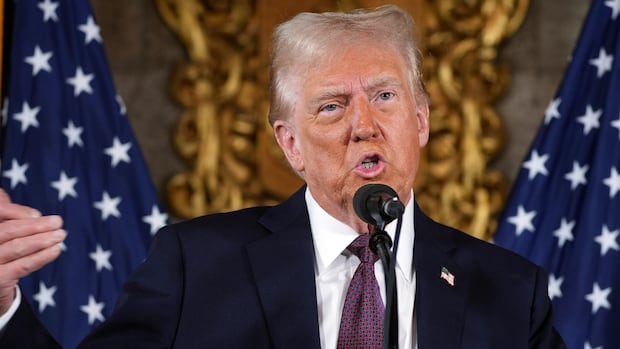Incoming U.S. president Donald Trump wants a U.S. takeover of the Danish autonomous territory of Greenland — and the idea is not nearly as far-fetched as it might sound.
In a bombastic press conference Tuesday, Trump reiterated recent calls to secure control of the world’s largest island and the Panama Canal, refusing to rule out economic or military coercion. He threatened to “tariff Denmark at a very high level” if it did not comply.
“Greenland is an incredible place, and the people will benefit greatly if and when it becomes part of our nation,” he wrote earlier Tuesday in a post to his social media network, Truth Social. “We will protect it, and cherish it, from a very vicious outside World.”
Trump’s remarks came as his son, Donald Trump Jr., visited the island on a highly publicized “personal trip,” meeting with locals and distributing “Make America Great Again” hats, according to Greenlandic daily Sermitsiaq. Several media reports also said the president-elect connected with locals for a brief video call, telling the group, “We’re going to treat you well.”
U.S. president-elect Donald Trump has said he wants to make Greenland an American territory, but residents of the Arctic island aren’t taking the threat too seriously, saying their land isn’t up for grabs. However, Trump’s comment is sparking global criticism over his stance on borders and alliances.
The combined offensive drew condemnation from Greenlandic and Danish politicians alike.
“I don’t want to be a pawn in Trump’s wet dreams of expanding his empire,” Aaja Chemnitz, one of Greenland’s two representatives in Denmark’s parliament, says in a translation of a Facebook post written in Danish and Greenlandic.
“It’s appalling — what’s going on right now” about the U.S. “taking over Greenland,” Søren Espersen, an opposition MP in Denmark, says in a Google translation of an X post written in Danish.
But within Greenland, the reaction was more muted. That’s because, amid an ongoing push for independence from Denmark, the U.S. is certain to be a key player in the territory’s future.
And while politicians like Greenlandic Prime Minister Múte B. Egede have been adamant that Greenland “is not for sale and will never be for sale,” there’s a reason to believe that Trump’s threat may carry some weight this time around.
Can Trump actually ‘buy’ Greenland?
Trump first floated the idea of buying Greenland in 2019 and resurrected the idea in a Christmas Eve post announcing his new ambassador to Denmark. The idea actually goes back to the 19th century, when the U.S. regularly acquired vast territories through agreements like the Louisiana Purchase.
But Greenland isn’t really “owned” by Denmark. Located much nearer to Canada’s Arctic territories than Europe, it has been a territory of the Kingdom since the 1800s, but over 90 per cent of its population of fewer than 60,000 people are Indigenous to the island.

It has had its own parliament and government since 1973, and a 2008 referendum laid a pathway to full independence if Greenlanders want it.
Under the current arrangement, Denmark maintains responsibility for some key portfolios including currency, foreign affairs and defence.
Since winning power in 2021, Egede’s pro-independence Inuit Ataqatigiit party has led a push for Greenland to pursue ties with other allies as part of a long-term strategy to move away from dependence on Denmark.

In a New Year’s Day address, Egede suggested that Greenland would finally make a formal move for independence with a referendum in 2025, likely during the upcoming April parliamentary election.
“It is now time to take the next step for our country,” Egede said. “Our co-operation with other countries, and our trade relations, cannot only continue to happen via Denmark.”
But independence from Denmark would come at a substantial cost to Greenlanders. According to the U.S. Department of Commerce, the island receives what is called a “block grant” of about 3.9 billion Danish kroner (roughly $775 million Cdn) in financial transfers from Denmark each year.
“Greenland wants independence. Every poll shows it,” said Mikkel Runge Olsen, a senior researcher at the Danish Institute for International Studies. “But Greenland cannot afford to keep the Greenlandic welfare state going without a significant infusion of cash from elsewhere.”

That’s why some politicians have suggested Greenland could swap its arrangement with Denmark for a “free association agreement” with the U.S. These agreements transfer responsibility for some portfolios, like defence, to another country in exchange for financial transfers.
It’s not quite a purchase — there is no scenario, for example, where Greenland would become a state or federal dependency of the U.S. — but it would mean a substantial change in relations. It’s something some Greenlandic politicians have long advocated for.
“We do not have a natural relationship with Denmark. We have a forced marriage,” Pele Broberg, leader of Greenland’s largest opposition group, told Sermitsiaq. “The Danes are nervous about the power that the United States has to bring us into the 21st century.”
Why does Trump want Greenland?
Since his re-election, Trump has been relentless in pushing for the expansion of U.S. territory, including suggesting Canada become a “51st state.”
In Greenland’s case, Trump has said owning the island is “an absolute necessity” for U.S. national security, and that the people of Greenland “want the U.S. to be there.”
There is some truth to these statements.
Since the Cold War, Greenland has been seen as a key strategic location for the U.S. military. The Pituffik Space Base, formerly an air base, was built in 1943 and is the military’s northernmost air base.

With warming Arctic temperatures opening new sea routes, and amid rising tensions with Russia and China, Greenland — and even Denmark — increasingly sees the advantage of a muscular U.S. presence.
“We have a clear interest that it’s the U.S. that plays a large role in that region, and not, for example, Russia,” Danish Prime Minister Mette Fredricksen said Tuesday.
The island is also home to some of the world’s largest reserves of rare earth metals. Even if Egede’s government has been quick to ban some extractive industries, Greenlanders on the whole are open to the idea of exploiting the island’s natural resources — a 2022 survey found three in four Greenlanders in favour.
But with the U.S. military already camped on Greenland, and Greenlanders already open to U.S. investment, many experts are confused about what Trump stands to gain.
“What would the U.S. actually get out of it, except having to pay for supporting the Greenlandic population?” asked Kristian Søby Kristensen, director of the Institute for Military Studies at the University of Copenhagen.
‘The resurrection of Manifest Destiny’
For Rob Huebert, an associate professor and Arctic politics expert at the University of Calgary, the answer may be ideological.
“It’s the resurrection of Manifest Destiny,” he said, referring to a 19th-century idea that the U.S. has a divine right and duty to expand its influence across the globe.
“You’ve already got everything you could possibly want [in Greenland], except the right to put up a flag,” he said.
Huebert says Trump tends to think of foreign relations in terms of “spheres of influence” — in other words, dividing up the world between great powers like Russia and the U.S., who are then free to throw their economic and military weight around.
“Basically, not only is he threatening our sovereignty, but he’s threatening to take us back to a world order that is a recipe for an international disaster,” Huebert said.
U.S. president-elect Donald Trump continued to threaten significant tariffs and said he would be willing to use ‘economic force,’ rather than military force, to join Canada and the United States together.
Huebert said Greenland, Denmark and Canada should take a strong stance condemning Trump’s threats of aggression.
But for now, at least, Greenland’s politicians seem to be taking the opposite approach.
“I think we are all doing ourselves a favour by getting our heart rate down a bit,” Lars Løkke Rasmussen, the foreign minister, told reporters Wednesday.
“Danes, Americans and everyone else can have opinions, but we should not get caught up in the hysteria,” Egede, the prime minister, said in a Tuesday Facebook post. “Our future is ours and must be drawn by us.”



